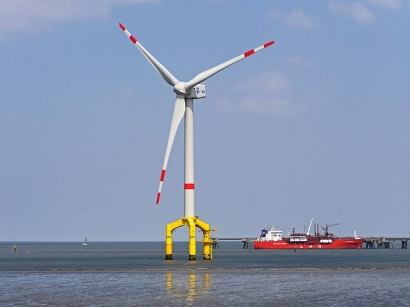
GW-scale electrolysis and large industrial demand
The SeaH2Land vision includes a renewable hydrogen production facility of 1 GW by 2030 to be developed by Ørsted. If realized, the electrolyzer, which will produce the renewable hydrogen, can convert about 20% of the current hydrogen consumption in the region to renewable hydrogen.
With 580,000 tons per year, the North Sea Port cluster is one of the largest production and demand centers of fossil hydrogen in Europe today. Driven by decarbonization efforts, industrial demand in the cluster could grow to about 1,000,000 tons by 2050, equivalent to roughly 10 GW of electrolysis.
GW electrolyzer directly linked to new 2 GW offshore wind farm
Ørsted proposes to connect the GW electrolyzer directly to a new 2 GW offshore wind farm in the Dutch North Sea. This will enable the large-scale supply of renewable electricity required for production of renewable hydrogen and fits well with the ambitions of the Dutch authorities for an accelerated offshore wind roll-out in line with increasing electricity demand. The offshore wind farm could be built in one of the zones in the southern part of the Dutch exclusive economic zone that has already been designated for offshore wind development.
Regional infrastructure and hydrogen exchange between big industrial players
The industrial players in the region, united in the Smart Delta Resources (SDR) industry partnership, will continue the dialogue with TSOs for them to develop a regional open-access pipeline network of about 45 km, stretching across the North Sea Port area from Vlissingen-Oost (NL) to Gent (BE).
The GW electrolyzer is proposed to link to the envisaged regional pipeline system connecting large-scale consumption and production in the cluster. Yara, in consortium with Ørsted, and Zeeland Refinery have each announced plans for mid-size renewable hydrogen production at their sites, while Dow has been exporting hydrogen to Yara since 2018 through the world's first conversion of a gas pipeline into hydrogen. The network can be extended further south to ArcelorMittal as a short-term no-regret and further north, underneath the river Scheldt, to Zeeland Refinery, as a crucial link to create a unique regional ecosystem of hydrogen exchange with significant carbon reduction in the manufacturing processes of ammonia, chemicals, and steel and a significant contribution to the European Green Deal.
Moreover, the cluster strategy proposes to extend the 380 kV high-voltage network for the electrification needs of the industry south of the river Scheldt. This would enable GW-sized electrolysis and offshore wind landing zones on both sides of the river, turning the cluster into a true energy hub.
Phased build-out of electrolyzer capacity
Subject to a regulatory framework being in place, the regional network will unlock the first phase of SeaH2Land, which comprises 500 MW of electrolyzer capacity. The second phase of SeaH2Land which scales the electrolyzer capacity to 1 GW will require the possibility to connect to a national hydrogen backbone, providing additional flexibility and storage. Several locations north and south of the river Scheldt have been identified for GW-scale electrolysis. In the meantime, several projects are being developed in the region on the sites of industrial players, such as Zeeland Refinery's envisaged 150 MW electrolyzer, which are also to be connected to the network.
Dialogue with regulatory authorities
The partnership will now move forward and engage in dialogue with the regulatory authorities on the framework and policies needed to support the development of renewable hydrogen linked to large-scale offshore wind, the regional infrastructure, and conduct a full feasibility study of the project. This ambition fits well with the Hydrogen Delta Program for the region, developed by Smart Delta Resources - the association of industrial companies in the region - and supported by the Provinces of Zeeland and Oost-Vlaanderen.
Roles between partners
If realized as envisaged, Ørsted - the world leader in offshore wind - will develop the offshore wind farm and electrolyzer. North Sea Port - the port stretching from Zeeland (NL) into Flanders (BE) - and Smart Delta Resources will take the lead in developing the regional infrastructure in close collaboration with the TSOs, supported by the provinces of Zeeland and Oost-Vlaanderen.
The biggest industrial companies in the region, ArcelorMittal - the world's largest steel producer outside China, Yara - the world's leading ammonia producer, Dow - one of the biggest material science companies in the world, and Zeeland Refinery - owned by leading oil and gas companies and a co-supplier of low-carbon hydrogen to the network - will continue to take part in the hydrogen exchange in the industrial cluster. The industrial demand in the region will provide the offtake of renewable hydrogen when the right framework conditions and economics are in place.

